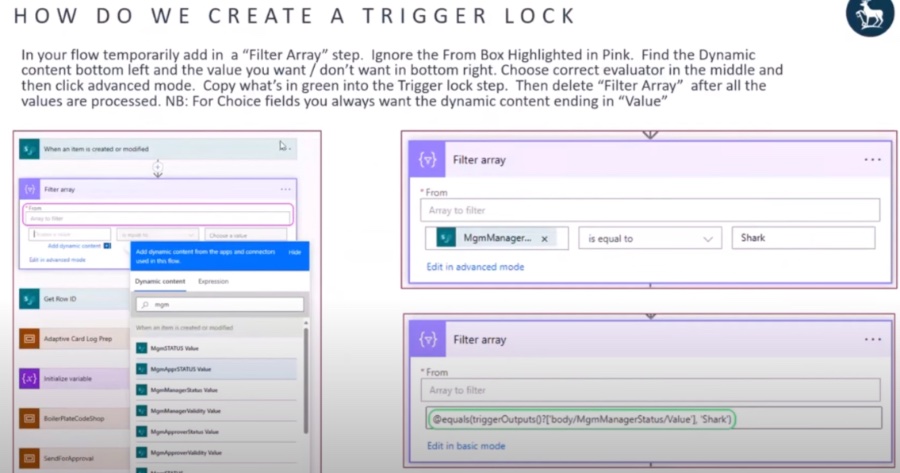
Power Automate Advanced: Treat flows as functions
Software Development Redmond, Washington
Maximize Power Automate efficiency: Learn to use flows like functions with expert Jason Murphy.
Key insights
Power Automate Advanced Functions: Jason Murphy of the University of Surrey presented advanced techniques for the Power Automate tool in a 13-minute session. He emphasized the concept of treating flows as functions, enhancing the capability of Power Automate for more complex and functional operations.
The presentation was part of the Microsoft 365 & Power Platform Development Community call on November 9th, 2023. These community calls are open to everyone and aimed at sharing knowledge and developments about Microsoft technologies.
SharePoint REST Service Integration: Developers can now use the REST service in SharePoint for CRUD operations on data by leveraging any technology that supports REST web requests. The service complements existing client object models and is geared towards SharePoint Add-ins, solutions, and client applications.
To interact with SharePoint objects using REST, developers must construct RESTful HTTP requests following the OData standard. SharePoint's client.svc web service processes these requests and returns responses in Atom or JSON format, which must be parsed by the developer's client application.
Using HTTP Commands with SharePoint REST: SharePoint's built-in REST capabilities are accessed by constructing RESTful HTTP requests that mirror client object model APIs. These allow for doing typical CRUD operations against SharePoint entities such as lists and sites, using various HTTP methods like GET, POST, PUT, and DELETE.
For constructing REST URLs to access SharePoint resources, the URI schema is designed to mimic the resource's API signature from the SharePoint client object model. Endpoints in the SharePoint REST service align with types and members in the SharePoint client object models.
Sample REST Endpoints and Operations: Specific REST URIs can be constructed by "walking" the object model, following the API names from the client object model. The REST service offers various endpoint URL examples for retrieving a site's title, working with lists and list items, and creating or updating resources, all of which are demonstrated with HTTP methods and potential body content.
- Presenting advanced Power Automate functions.
- Understanding SharePoint REST for CRUD operations.
- Constructing HTTP RESTful requests using OData.
- Accessing SharePoint objects with various HTTP methods.
- Examples of REST endpoint URLs for typical operations.

Exploring SharePoint Development
SharePoint, a leading web-based collaborative platform by Microsoft, offers a myriad of development capabilities. For developers aiming to streamline operations within SharePoint sites, understanding and effectively leveraging the SharePoint REST Service is crucial. The REST service integrates with existing SharePoint solutions, allowing for improved data manipulation and interactivity across platforms. With SharePoint's OData-compliant interface, developers can perform CRUD operations across different SharePoint entities using standard web technologies. As SharePoint remains a pivotal tool in enterprise collaboration and content management, keeping abreast of such development techniques aligns with the ever-growing demand for sophisticated and efficient SharePoint solutions.
In a detailed 13-minute session by Jason Murphy from the University of Surrey, the complexities of Power Automate are examined with a focus on treating flows much like functions. Murphy, presenting during a Microsoft 365 & Power Platform Development Community call, offered a deep dive into optimizing these flows for more intricate operations. The session, held on November 9th, 2023, was part of a series open to all attendees and aimed to enhance understanding of Power Automate’s capabilities.
SharePoint's REST service parallels the established client object models, allowing remote interactions with SharePoint data via REST web requests. Developers now have the tools to perform comprehensive Create, Read, Update, and Delete (CRUD) operations from a plethora of solutions and applications. Assuming a basic knowledge of REST, one can access SharePoint sites remotely and carry out various operations using standard RESTful HTTP requests aligned with the OData syntax.
To interact with SharePoint objects directly, one must utilize HTTP requests conforming to OData standards which reflect the desired client object model API. Examples provided demonstrate how to leverage the client.svc web service for handling requests and how responses in Atom or JSON format should be interpreted by client applications. However, even with the convenience offered by these models, for .NET Framework, Silverlight, or JavaScript, they remain a preferred method for SharePoint communication.
Well-structured HTTP commands paired with the OData standard allow for the performance of typical CRUD operations on SharePoint entities like lists and sites. Each SharePoint REST service endpoint correlates with the types and members found within the SharePoint client object models. The article outlines the correct HTTP requests to use for reading, creating, updating, or deleting resources, providing a comprehensive guide to the REST service usage for such operations.
Formulating REST URLs to access SharePoint resources is straightforward, mimicking the API signature of the corresponding client object model resource where possible. Starting points are usually site collection and site endpoints indicated by specific URLs, and from there, more detailed REST URIs can be constructed. The article doesn't cover SocialFeedManager or SocialFollowingManager REST APIs but provides initial guidelines and typical REST endpoint URL examples to get started with SharePoint data handling.
The SharePoint REST service also supports combining numerous requests into a single service call, offering developers convenience and efficiency. This mechanism and links to code samples are discussed in the context of batch job support, which can be pivotal for managing complex data operations. Developers are encouraged to utilize the vast array of available resources to expand their knowledge and proficiency with the SharePoint REST service.
Understanding Power Automate
Power Automate is an essential tool for creating automated workflows between apps and services, offering time-saving benefits and structured data management. Its ability to handle complex processes and integrate with various Microsoft products like SharePoint makes it a versatile solution for automating repetitive tasks. Power Automate helps users to streamline their operations, increase efficiency, and reduce errors in daily tasks. Its integration with SharePoint through REST APIs expands its capabilities, making it easier for developers to manipulate data and automate processes. Overall, Power Automate is a powerful asset for both developers and non-technical users in optimizing business workflows.
Power Automate Advanced Techniques
In a detailed 13-minute session, Jason Murphy provides an insightful look into advanced application of Power Automate. He discusses the concept of treating automation flows similarly to functions, vastly improving their functionality. These techniques enhance the capability to handle more complex processes.
The demonstration is a segment of the Microsoft 365 & Power Platform Development Community call. It's an open and welcoming environment for learning, with invites accessible for future sessions. Note: external links and social media references have been removed from this summary.
Presenter: Jason Murphy is associated with the University of Surrey, bringing academic expertise to the discussion.
Interacting with SharePoint Data
SharePoint’s REST service enables developers to perform CRUD operations remotely using a technology that supports REST web requests. By utilizing REST and OData syntax, these actions can be easily integrated within SharePoint Add-ins and solutions. This opens up a direct line of communication with SharePoint objects.
No prior knowledge is assumed beyond a basic understanding of REST and the structure of REST requests. This addition by SharePoint paves the way for developers to engage with SharePoint sites from any location, enhancing the flexibility and reach of their applications.
HTTP requests via client.svc web service in SharePoint yield responses in Atom or JSON format, which developers must interpret. The overarching architecture of the SharePoint REST service is designed to be user-friendly while still providing the robust features of client object models.
Utilizing SharePoint REST Service
To leverage SharePoint’s built-in REST capabilities, developers craft RESTful HTTP requests that align with client object model APIs. These requests are managed by the client.svc web service, and responses come in Atom or JSON formats which the developer's application must then parse and interpret.
REST endpoints in the service are mapped closely to SharePoint client object models, making CRUD operations against SharePoint entities like lists and sites possible. Specific HTTP requests allow developers to read, create, update, or delete resources effectively.
The flexibility of REST URLs in SharePoint allows developers to navigate the SharePoint data structure in an intuitive manner. From retrieving the title of a site to creating lists or adding items, developers can construct REST endpoint URIs by following the service’s high-level object model structure.
Advanced Operations and Resources
Multi-request batch jobs are supported in the SharePoint Online platform, enabling the consolidation of operations into a single call. This not only saves time but also improves efficiency when interacting with the REST API. While following documentation is key, these code samples and resources aid developers in maximizing the REST service use.
OData, a protocol for building and consuming RESTful APIs, is central to SharePoint REST operations, which is supported through various resources and extensive documentation. The aim is to allow developers to integrate SharePoint data seamlessly into their applications, whether it's adding search functionality or managing social feeds.
Feedback and additional resources continue to be an important aspect of developing in SharePoint, calling for a community-driven approach to improvement and innovation. It’s important to note that when working with SharePoint REST services and OData, specifics and syntax are subject to change, thus developers should always refer to the latest documentation.
Understanding SharePoint and Power Automate
SharePoint and other similar automation tools offer advanced functionality for developers through REST APIs and automation strategies. By thinking of workflows as functions, users can greatly enhance their productivity, allowing for automation of complex tasks. Integrating RESTful operations into SharePoint solutions opens up new avenues for managing data and building feature-rich applications.

Read the full article Power Automate Advanced: Treat flows as functions
People also ask
What are the three types of flows you can create with Power Automate?
In Power Automate, you can create three main types of flows: Automated flows trigger automatically when a specified event occurs, such as receiving an email or a new item being added to a list. Scheduled flows run at a set time, which can be on a specified date and time or on a recurring basis. Finally, Business process flows guide users through a set of steps or tasks that reflect a business process, ensuring data consistency and compliance.
What are the functions in Power Automate flow?
The functions in Power Automate flow include a wide array of predefined operations that help in tasks such as manipulating data, working with dates and times, performing mathematical calculations, handling string values, controlling flow actions, and more. These functions are similar to functions found in Excel and can be categorized under String, Collection, Logical, Math, Date and Time, Conversion, and Workflow.
What is the Power Automate expression function?
The Power Automate expression function refers to the formulas that one can use within Power Automate to perform various operations on data. Similar to functions in programming languages, expression functions in Power Automate can help to carry out complex processing tasks, manipulate data dynamically, and enable advanced logic within flows. They are used in the dynamic content menu and can be combined with other functions or used alone to achieve desired results.
How do you save flow as in Power Automate?
To save a flow in Power Automate, you typically finish constructing or editing your flow and then click on the "Save" button, often located at the top right corner of the flow editor. If you want to save a flow as a template for future use, you may go to "Save As" to save a copy of the flow with a different name, allowing you to reuse and modify the flow for other purposes without impacting the original.
Keywords
Power Automate Functions, Advanced Flow Techniques, Power Automate Parameters, Function-like Flows, Reusable Power Automate Flows, Power Automate Flow Logic, Modular Flows in Power Automate, Power Automate Best Practices, Custom Functions in Power Automate, Efficient Power Automate Flows